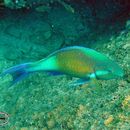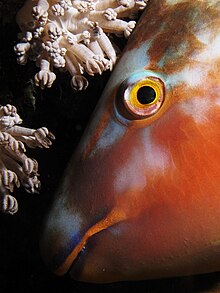Trophic Strategy
provided by Fishbase
Inhabits coastal regions associated with coral reefs and reef flats (Ref. 9710). Present in seagrass beds at juvenile stage (Ref. 41878). Forms groups consisting of a terminal phased individual and numerous individuals in the initial phase (Ref. 9710). Herbivorous, feeds on benthic algae (ref. 43650)..
- Recorder
- Drina Sta. Iglesia
Biology
provided by Fishbase
Inhabits coastal regions associated with coral reefs and reef flats. Forms groups consisting of a terminal phased individual and numerous individuals in the initial phase (Ref. 9710). Feeds on benthic algae (Ref. 30573). Caught with nets and other artisanal gear. Mainly sold fresh.
Comprehensive Description
provided by Smithsonian Contributions to Zoology
Scarus harid Forskal
Scarus harid Forskål, 1775, pp. x, 30.
Scarus psittacus Forskål, 1775, pp. x, 29.
For additional synonyms, see each subspecies of Scarus harid.
The identity of Scarus psittacus Forskål (type-species of the genus Scarus Forskål): Dr. Smith (1959, pp. 265–282) made a major contribution toward an understanding of the identity of the widely ranging species of parrotfish, Scarid harid Forskål of the Western tropical Pacific Ocean, Indian Ocean, and Red Sea, when he differentiated three forms that comprise the harid-complex of species. Jordan and Gilbert (1882, p. 938) designated Scarus psittacus Forskål as the type-species of the genus Scarus Forskål; however, Smith (loc. cit.) rejected Schultz’s interpretation of S. psittacus, which he (1958 p. 29) accepted as being the same species on S. harid on the basis of Forskål’s description. With this difference of opinion prevailing, the problem of the identity of S. psittacus is given further consideration.
Smith (1956, pp. 4, 17) established the new genus Hipposcarus, with Scarus harid Forskål as its type-species, thus rejecting Scarus, which had been accepted and in use for over a century and a half (Block and Schneider, 1801, p. 294; Rüppell, 1828; Bennett, 1828, p. 37; Cuvier and Valenciennes, 1839).
Since the holotype of Scarus psittacus Forskål is no longer in existence, I have translated the Latin description by Forskål (1775, p. 29) as follows:
[Diagnosis] Green; golden yellow lines; fins marked by borders, band ventrally; characteristic blue head.
Description. Maxillary of two parts, separated at middle, crenulate; on both sides above three teeth project; the lower [jaw] both sides, one. They are blue, the margins of both lips. Curved line extends from upper lip to below eye; a line transverses each side of each lower lip. A median longitudinal line on lower part of head, longitudinal line to lower [posterior] border of opercle. Opercle completely covered with large scales. Fins mostly crimson, borders blue, pectorals only marked above, ventrally opposite the dorsal. Caudal forked, fin blue spotted, middle truncate, both marginal angles produced. Scales striate. Lateral line with little branches, double, first straight, near back, ending under end of dorsal fin, the other located below [behind] in middle of body and extends straight to middle caudal. Base caudal fin on both sides with 3 large scales. In dorsal fin first 9 rays simple, nonridged, not pungent. Eye small, free. From Djiddah [Red Sea].
Smith (1959, pp. 275–276) described Scarus harid Forskål as follows:
In our work in the W. Indian Ocean we got large numbers of “harid.” From the beginning I was puzzled by certain constant differences in markings from the descriptions of Rüppell and Klunzinger (and Rüppell 1828, pl. 21, figs. 1, 2); both state Red Sea fishes have a yellow line from rictus to operculum: several lines of blue spots along mid-side above anus, and the body of the caudal uniform; the only recent account of harid from the Red Sea is one of a few lines by Roux-Estève (1956:94), he mentions this yellow line on the cheek, and the uniform dark violet caudal.
Smith (1959, pp. 276, 280) gives the following diagnosis of Hipposcarus hand harid (Forskål): “… yellow line from rictus to operculum; lines of blue spots on mid-side above anus; body of caudal uniform.” Forskâl’s diagnosis of “golden yellow lines” and his “Description” of a median longitudinal line on lower part of head, “Longitudinal line to lower [posterior] border of operculum,” appears to be the same as Smith’s “yellow line from rictus to operculum.”
Forskål (1775, p. 29), Ruppell (1828, pl. 21: figs. 1, 2), Klunzinger (1871, p. 561), Roux-Estève (1956, p. 94), and Smith (1959, p. 276) mention or illustrate a Red Sea parrotfish (“harid”) with a yellow line across the lower side of the head from the corner of the mouth to the rear of the opercle, and since no other species of parrotfish with such a golden line has been described, it is concluded that Scarus psittacus Forskål is the same species that Smith recognized as Scarus harid Forskål. Actually, Forskål’s description is more diagnostic for S. psittacus than his description is for that of S. harid. I conclude that the identification of S. psittacus (not Linnaeus) Forskål is not in doubt and should be accepted.
As the logotype for Petronason Swainson, Jordan (1919, p. 199) gave Coryphaena psittacus Linnaeus (=Xyrichthys psittacus Linnaeus), confusing that labrid with the scarid Labrus psittacus Linnaeus (=Scarus psittacus Forskål). Although S. psittacus Forskål is available for the scarid with the golden yellow line across the cheek, I prefer to continue, as first reviser (1958, p. 50), the long-time use of Scarus harid Forskål, because of the considerable confusion of the name Labrus psittacus Linnaeus, a labrid, with Cory phaena psittacus Linnaeus, a scarid.
The remnants of the type-specimen of Scarus harid Forskål was illustrated by Smith (1959, p. 275, fig. 6) and Klausewitz and Nielsen (1965, p. 14, pl. 3: fig. 7). It no longer retains any important identifying characteristics; the identity of harid must be determined on the basis of Forskål’s descriptions and later descriptions of harid by Rüppell and by Klunzinger, both of whom may have seen the type of Scarus harid when it was in better condition. For the sake of stability of nomenclature, I accept the identity of harid as defined by Smith (1959) and redefined in this paper.
Klausewitz and Nielsen (1965, p. 12) did not find the type of Scarus psittacus Forskål. Dr. Jergen Nielsen in a leter dated 21 May 1960, sent four photographs to me that represented all of the existing types of Forskål’s species of Scarus as follows: “Scarus harid, Scarus niger, Scarus siganus, and Scaris gallus.” The last two are not parrotfishes. Dr. Nielsen made the following comments:
A few days ago I received the photographs of the types of Scarus from the collection of Forskål. They are all enclosed in this letter.
Unfortunately, nearly all of the 72 Forskå l fishes have only the skin preserved. A few specimens also have some ribs and headbones left, but none of the four species of Scarus has the faintest trace of pharyngeals. So I am afraid I can help you only with photographs.
In order to stabilize the nomenclature of the family Scaridae (in case the identity of the genotype Scarus pattacus Forskål is still in some doubt), because no type-specimen exists, and because this paper is a continuation of my revision (1958, pp. 29, 50–52), I herewith select a neotype for Scarus psittacus Forskål: USNM 201805, a specimen from the Red Sea, 182 mm in standard length, with characteristics as defined in this paper for S. h. hand Forskål. This action is based on Article 75 of the International Code of Zoological Nomenclature (1961, pp. 81–82).
Among the forms composing the Scarus harid complex, Smith (1959, pp. 174–288) recognized harid (Red Sea), vexillus (Western Indian Ocean), and schultzi (tropical western Pacific Ocean). Smith distinguished harid and vexillus from longiceps (=schultzi) by the fact that the width of the patch of cheek scales are less than the width of the interorbital in harid-vexillus and wider than the interorbital for longiceps (=schultzi). I have measured both characters to the nearest tenth of a millimeter, divided the maximum width of the patch of cheek-scales into the width of the fleshy interorbital, and obtained the ratio for each specimen correlated with its standard length (Table 1). This table shows that the ratio decreases with increased size of the specimens and that the ranges of the ratios overlap for the three forms, with the result that this character alone cannot be used for the separation of the species.
I have made a comparison of certain body dimensions for the three subspecies of S. harid (Table 2). This table shows that the greatest width of the patch of cheek scales averages a little wider (75 to 99 thousandths of standard length) in S. h. longiceps compared with that (55 to 89) in the other two subspecies. It is, however, the only character measured that showed a significant difference. Although S. h. vexillus has a greater number of cheek scales than S. h. longiceps, the cheek scale patch is narrower in the latter.
Another character used by Smith for distinguishing the species in the harid-complex is the number of scales on the cheek (Table 3). This table reveals that vexillus has 22 to 31 scales on the cheek whereas harid and longiceps range from 15 to 22, the range overlapping at 22. Without doubt, S. h. vexillus may be distinguished from the other two by the number of scales in the patch on the cheek of adults.
- bibliographic citation
- Schultz, Leonard P. 1969. "The taxonomic status of the controversial genera and species of parrotfishes with a descriptive list (family Scardiae)." Smithsonian Contributions to Zoology. 1-49. https://doi.org/10.5479/si.00810282.17
Hipposcarus harid: Brief Summary
(
French
)
provided by wikipedia FR
Poisson-perroquet jaune, Perroquet candelamoa
Hipposcarus harid est une espèce de poissons-perroquets de la famille des Scaridae. Originaire de l'Indo-Pacifique tropical, il est parfois appelé en français « Poisson-perroquet jaune » ou « Perroquet candelamoa ».
- license
- cc-by-sa-3.0
- copyright
- Auteurs et éditeurs de Wikipedia
Description
provided by World Register of Marine Species
Inhabits coastal regions associated with coral reefs and reef flats. Feeds on benthic algae. Caught also with nets and other artisanal gear. Sold mostly fresh in markets.
Froese, R. & D. Pauly (Editors). (2023). FishBase. World Wide Web electronic publication. version (02/2023).
- license
- cc-by-4.0
- copyright
- WoRMS Editorial Board


 Closeup of sleeping Hipposcarus harid at Shaab Mahmoud (Red Sea, Egypt)
Closeup of sleeping Hipposcarus harid at Shaab Mahmoud (Red Sea, Egypt)